Next stop: Roaring Forties
Published on January 19th, 2015
(January 19, 2015; Day 20) – The South is looming as the leading boats in the Barcelona World Race are expected to reach 40°S, the border post of the ‘deep south’, on Wednesday. For leaders Cheminées Poujoulat and their nearest rivals Neutrogena, as well as third-placed Gaes Centros Auditivos, today was a day to prepare – mentally, practically and tactically – for the fast-approaching challenges of the Southern Ocean.
At this morning’s 0900 position report there were just 10 miles dividing first and second position, and around 60 miles between them on the water. However, Guillermo Altadill and Jose Muñoz on Neutrogena have since opted to dive south, increasing the separation to almost 150 miles while Cheminées Poujoulat continues east.
Despite periods of solid north-westerly breeze, as the leading boats approach the front the conditions are becoming variable and challenging. Bernard Stamm (Cheminées Poujoulat) compared the situation to the Doldrums, reporting that last night they experienced a 37-knot squall, and commenting that “We are trying to preserve the boat first and foremost.”
For the leaders the questions are stacking up – to sail conservatively or keep the pressure on? To cross the front in search of stronger westerly breezes, or cover their rivals? Neutrogena appear to have ducked south for pressure this afternoon, bidding to be first into the building westerlies that will speed them towards the Cape of Good Hope. Whether it will pay off is unclear – Stamm commenting earlier today: “We are not waiting for the Southern Oceans, more we are trying to catch up with them. We are trying to go south to catch the westerly winds, it is not simple.”
The skippers are also preparing their boats, and their mindsets, for the demanding deep south. Gerard Marìn explained how he and Anna Corbella were shifting weight aft on GAES Centros Auditivos, in preparation for the surfing conditions expected as they head south: “We are still quite far from the Indian Ocean, but we are moving back all the stuff to the stern, putting all the stacking behind us, because we know that it can slam a lot and we need to try to have everything ready for that occasion.”
Speaking to school pupils during today’s live videoconference, he was asked what his best (and worst) moments of the race had been so far. For he and Anna the sense of achievement at remaining in touch – and critically, in the same weather systems – with the leading duos is huge: “Maybe the best has been the entire race so far. Now we’re getting close to the gateway to the South only 150 miles behind the leaders I think that is a joy.”
There is also the mental preparation for the challenge of diving into the inhospitable southern regions, and Gerard and Anna today received a well-timed confidence boost, blogging: “Today we found a big surprise. There was an envelope full of messages, pictures, letters and drawings from our relatives and our friends. It has been the best moral boost we could have at the gates of the deep South.
“It is quite curious that we haven’t found it until today. The emotion of that discovery is priceless. Exactly this morning we remarked that the toughest part of the race is about to come: the cold, the waves, the unexplored… and it is a little scary. Thanks to today’s surprise, GAES Centros Auditivos faces the next days with more strength.”
The leading trio can expect to experience broadly similar weather patterns to each other over the next 24 hours, with winds set to build to around 35 knots from the north-west before shifting to the south-west on Wednesday as the first boats cross the front.
For fourth-placed Renault Captur, however, conditions are markedly different, with Jörg Riechers and Sébastien Audigane suffering in a zone of light, unstable breezes to the north of the St Helena High, shedding 140 miles to the leaders over the past 24 hours.
Around 320 miles further west, Bruno and Willy Garcia on We Are Water are making steady progress south, while sixth-placed One Planet One Ocean Pharmaton have opted for a more westerly route , closer to the Brazilian coast. In seventh place Spirit of Hungary is benefitting from stable trade wind conditions to give them solid 12-knot plus averages.
Skippers’ quotes
Cheminées Poujoulat, Bernard Stamm:
“The night has been quite difficult, but it’s OK. We are not in the ‘Roaring Forties’, it looks more like the Doldrums. We got caught up in some terrible thunderstorms and between them there is no wind. We have a front to our South, it’s why the wind is so shifty, it’s a bit all over the place.
“We still are in shorts and tee-shirt. The temperature is good but we need to wear our oilskins – well, if you don’t want to be changing every 10 minutes you put them on anyway!
“We have had a lot of work with this front. We are trying to preserve the boat first and foremost. Last night we had squalls of more than 37 knots, whereas usually the wind is around 17-18 knots. We are not waiting f or the Southern Oceans, more we are trying to catch up with them. We are trying to go south to catch the westerly winds, it is not simple.
“Life on board with Jean is very pleasant. We hope the conditions will stabilise a bit to give us time to take a rest. Everything’s going well, there’s no problem, but there’s not time to talk and joke. Our aim is to try to catch the westerly wind as soon as possible.
“It is much too soon to see an albatross – our latitude is 33° south, the same latitude of Morocco in the north. We’re not in the deep south yet.”
Gerard Marin, GAES Centros Auditivos:
“Tonight we have been sailing quite well. The wind became quite strong, even when there was no prediction for it, but now there is about 20-25 knots astern. We are using the A5 and one reef and, well, it’s currently quite comfortable. There are some short waves which are slamming our boat. That’s the reason why we are a using sli ghtly reduced sail area. But, for now, the peaks are good and we’ll see if it brings any good waves and we could go faster.
“We are still quite far from the Indian Ocean, but we are moving back all the stuff to the stern, putting all the stacking behind us, because we know that it can slam a lot and we need to try to have everything ready for that occasion.
“Well, now we are sliding back a little, but we must keep our eyes open to watch how the depression develops that is coming from our stern. We need to use our experience and keep our heads sensibly. We are in a good position but there is still a lot to do and we would like to be quite conservative
Ranking at 14:00 UTC:
1. Cheminées Poujoulat (Bernard Stamm – Jean Le Cam) 19750.1 nm Distance to Finish
2. Neutrogena (Guillermo Altadill – Jose Muñoz) 68.3 nm
3. GAES Centros Auditivos (Anna Corbella – Gerard Marin) 118.1 nm Distance to Lead
4. Renault Captur (Jörg Riechers – Sebastien Audigane) 399.6 nm DTL
5. We Are Water (Bruno Garcia – Willy Garcia) 705.9 nm DTL
6. One Planet One Ocean / Pharmaton (Aleix Gelabert – Didac Costa) 903.6 nm DTL
7. Spirit of Hungary (Nandor Fa – Conrad Colman) 1126.8 nm DTL
Hugo Boss (Alex Thomson – Pepe Ribes) Abandon
Report by event media.
Background: The third edition of the Barcelona World Race is the only double-handed, non-stop, round the world race. Eight IMOCA 60 teams started December 31, 2014, with the intent to cover 23,450 nautical miles in a circumnavigation from Barcelona to Barcelona, putting the capes of Good Hope (South Africa), Leeuwin (Australia) and Horn (Chile) to port and the Antarctic to starboard. The finishes are forecasted for the end of March 2015.


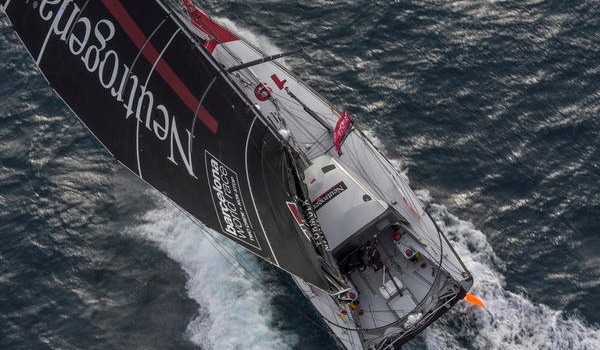


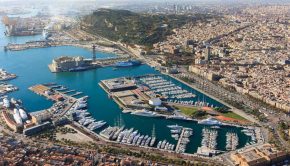
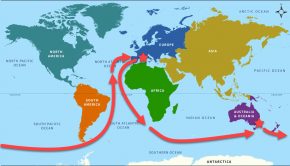
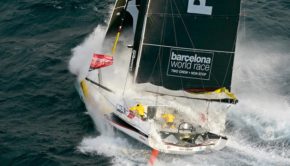
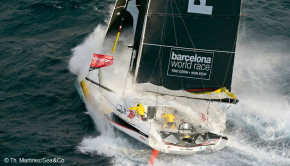
 We’ll keep your information safe.
We’ll keep your information safe.